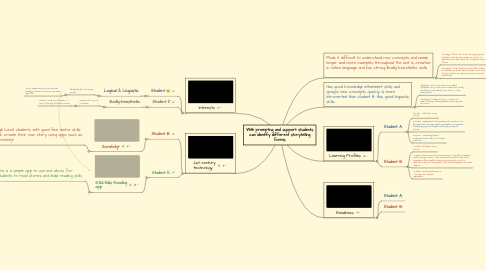
1. Interests
1.1. Student C:
1.1.1. Logical & Linguistic
1.1.1.1. Reading books and solving puzzles.
1.1.1.1.1. Story sequencing and word puzzles based on stories and forms. Use tech app RAZ
1.2. Student D
1.2.1. Bodily-kinesthetic
1.2.1.1. playing with toys and costumes.
1.2.1.1.1. create a small world based on a story. Role play different stories.
2. 21st century technology
2.1. Student B:
2.1.1. Scratchjr
2.1.1.1. High Level students with good fine motor skills can create their own story using apps such as Scratchjr.
2.2. Student E:
2.2.1. RAZ-Kids Reading app.
2.2.1.1. This is a simple app to use and allows for students to read stories and build reading skills.
3. Finds it difficult to understand new concepts and needs longer and more examples throughout the unit. Is creative in native language and has strong Bodily-kinesthetic skills. .
3.1. Strategy 1: Ask to tell stories through physical activities. Use role play center as a point of expression and then visual aids to explore other story forms.
3.2. Strategy 2: Little Teacher activity. Ask student to go around during center time and mark down what story forms students are exploring using a visual aid worksheet.
4. Has good knowledge attainment skills and grasps new concepts quickly. Is more introverted than student B. Has good linguistic skills.
4.1. Strategy 1: one on one discussions about different story forms with a flashcard activity identifying story telling forms and non story telling forms.
4.2. Strategy 2: Create a story in a form of their choosing. Verbally express why they like this form.
5. Learning Profiles
5.1. Student A:
5.1.1. Content - Different story forms
5.1.2. Process - experiment, solve puzzles, ask questions. Can be taught through logic games, investigations, mysteries. Reading, playing word games, making up poetry or stories.
5.1.3. Product - technology based evidence/stories, diary, and student portfolio.
5.2. Student B:
5.2.1. Content- Different story forms
5.2.2. Process- Keen sense of body awareness. They like movement, making things, touching. They communicate well through body language and be taught through physical activity, hands-on learning, acting out, role playing. Tools include equipment and real objects.
5.2.3. Product- active performance, role play and creative expression.
